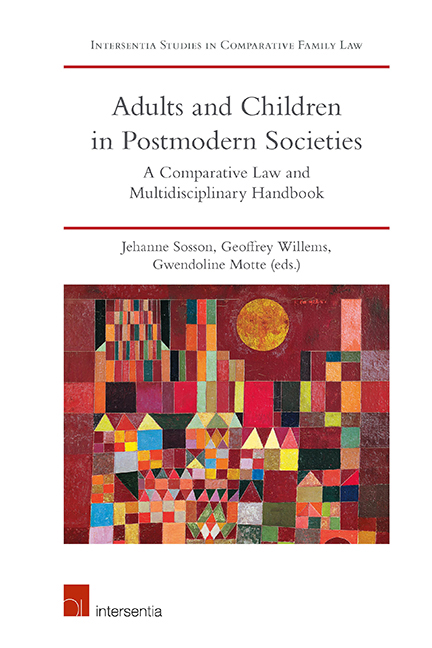Book contents
- Frontmatter
- Contents
- List of Cases
- List of Contributors
- Introduction
- PART I NATIONAL REPORTS ON LEGAL REGULATIONS OF RELATIONSHIPS BETWEEN ADULTS AND CHILDREN
- Questionnaire
- Models
- Algeria
- Argentina
- Australia
- Belgium
- Canada
- Democratic Republic of the Congo
- England and Wales
- France
- Germany
- Ireland
- Italy
- Japan
- The Netherlands
- Romania
- Spain and Catalonia
- Sweden
- Switzerland
- United States of America
- PART II INTERDISCIPLINARY APPROACH
- PART III INTERNATIONAL LAW INSIGHTS
- PART IV COMPARATIVE APPROACH
- General Conclusion: The Challenge of Transparent and Inclusive Parenthood/Parentality in a Pluralist and Cosmopolitan Context
- About the Editors
Sweden
from PART I - NATIONAL REPORTS ON LEGAL REGULATIONS OF RELATIONSHIPS BETWEEN ADULTS AND CHILDREN
Published online by Cambridge University Press: 26 June 2019
- Frontmatter
- Contents
- List of Cases
- List of Contributors
- Introduction
- PART I NATIONAL REPORTS ON LEGAL REGULATIONS OF RELATIONSHIPS BETWEEN ADULTS AND CHILDREN
- Questionnaire
- Models
- Algeria
- Argentina
- Australia
- Belgium
- Canada
- Democratic Republic of the Congo
- England and Wales
- France
- Germany
- Ireland
- Italy
- Japan
- The Netherlands
- Romania
- Spain and Catalonia
- Sweden
- Switzerland
- United States of America
- PART II INTERDISCIPLINARY APPROACH
- PART III INTERNATIONAL LAW INSIGHTS
- PART IV COMPARATIVE APPROACH
- General Conclusion: The Challenge of Transparent and Inclusive Parenthood/Parentality in a Pluralist and Cosmopolitan Context
- About the Editors
Summary
CHANGES IN THE TRADITIONAL FAMILY
A. MOTHERS
1. Is maternity automatically established by the birth certificate?
Maternity is established through the notification of a child's birth to the national population register. Unlike many other countries, Sweden does not issue ‘birth certificates’ per se. Rather, information is entered onto the national population register, which is administered and maintained by the Swedish Tax Agency. Extracts from the register are issued when they are needed for specific purposes.
If the child is born in a Swedish hospital, the notification of birth must be made to the population register by the hospital. If a midwife assists with the birth, it is the midwife who is responsible for making the birth notification. In other situations, the child's custodian/s make the notification within one month of the child's birth.
It should be mentioned that, with the exception of defining motherhood following egg donation (see Q. 17), the Children and Parents Code (SFS 1949.381) contains no general statutory provision clarifying maternity. In its absence, Swedish law continues to apply the unwritten presumption of maternity which stems from the Roman-law principles mater semper certa est (the mother is always certain) and mater est quam gestatio demonstrat (by gestation the mother is demonstrated).
The mother of the child is, thus, the woman who gives birth to the child, and who is registered in the population register as the child's mother.
2. Does your jurisdiction recognise any kind of ‘anonymous childbirth’?
No.
3.– 4. If any kind of ‘anonymous childbirth’ is recognised, what rights does the natural mother have in respect of the child? / In the same situation, what are the child's rights in respect of the natural mother (and her other children)?
Not applicable under Swedish law.
B. FATHERS
5. Is paternity automatically established by way of a presumption? If yes, does the presumption only apply within marriage?
A man who is married to the child's mother at the time of the child's birth is automatically deemed to be the legal father of the child. That is to say, his paternity is presumed and automatically established through marriage. His paternity, however, may be revoked in certain situations, as set out in the Children and Parents Code.
- Type
- Chapter
- Information
- Adults and Children in Postmodern SocietiesA Comparative Law and Multidisciplinary Handbook, pp. 515 - 550Publisher: IntersentiaPrint publication year: 2019



